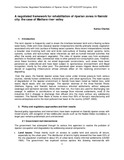| dc.description.abstract | The term riparian is frequently used to mean the interface between land and a flowing surface
water body. Older and more classical riparian interpretations identify primarily woody vegetation
associated only with lotic (surface of flowing water) systems. More recent interpretations include
a broader view involving both lotic and lentic (sub-surface of flowing water) systems, lentic
systems, surface and sub-surface water influences as well as human–induced activities that
affect the woody and emergent vegetation. The roles of riparian areas vary from ecological,
aesthetic or theatrical roles, commercial roles to other general non-consumptive uses. However,
since these functions often do not entail large-scale constructions, such areas have been
perceived as underutilized and have been subject to spontaneous encroachment and illegal
occupation, mostly by the urban poor. The perceived open access triggers dense settlement
devoid of supporting infrastructure whose ultimate effect on the receiving environment is
degrading.
Over the years, the Nairobi riparian areas have come under intense pressure from various
sources, namely human settlements, industrial activity, and urban agriculture. The main causes
of degradation of the riparian environment in Nairobi have been noted as habitat loss, solid
waste, liquid waste, and raw sewage. The riparian reserves of the three Nairobi Rivers
(Mathare, Ngong, and Nairobi) feature numerous informal settlements without adequate
sewerage and sanitation services. More often than not, the rivers are used for discharging raw
sewage. In addition to contributions of raw sewage from informal settlements, most of the
industries find it cheaper to discharge their effluent into the rivers without any satisfactory
treatment. The Nairobi River Basin is home to more than 50% of Kenya’s manufacturing and
service enterprises and is the most polluted river basin in the country (UNEP, 2003). | en |

